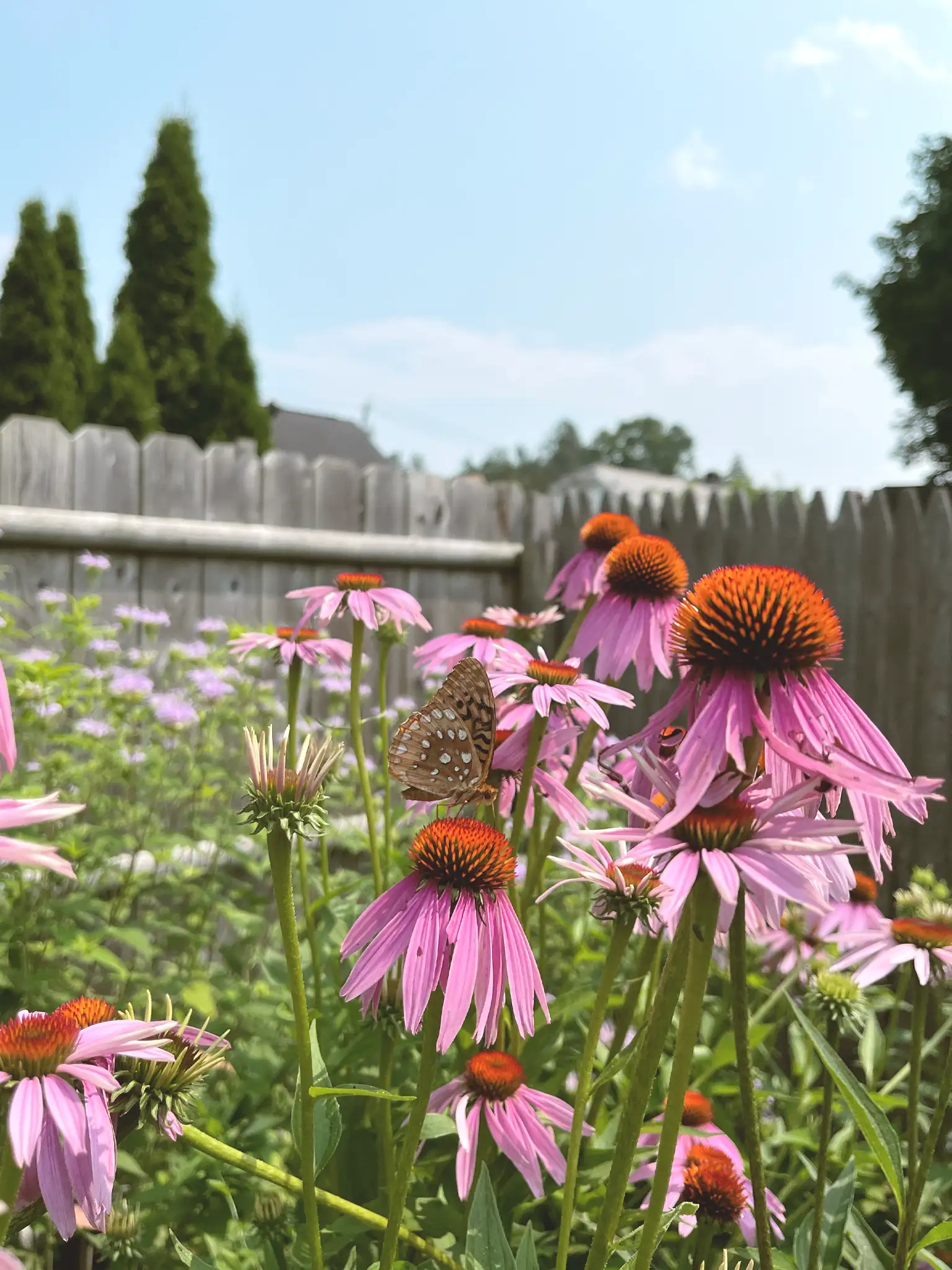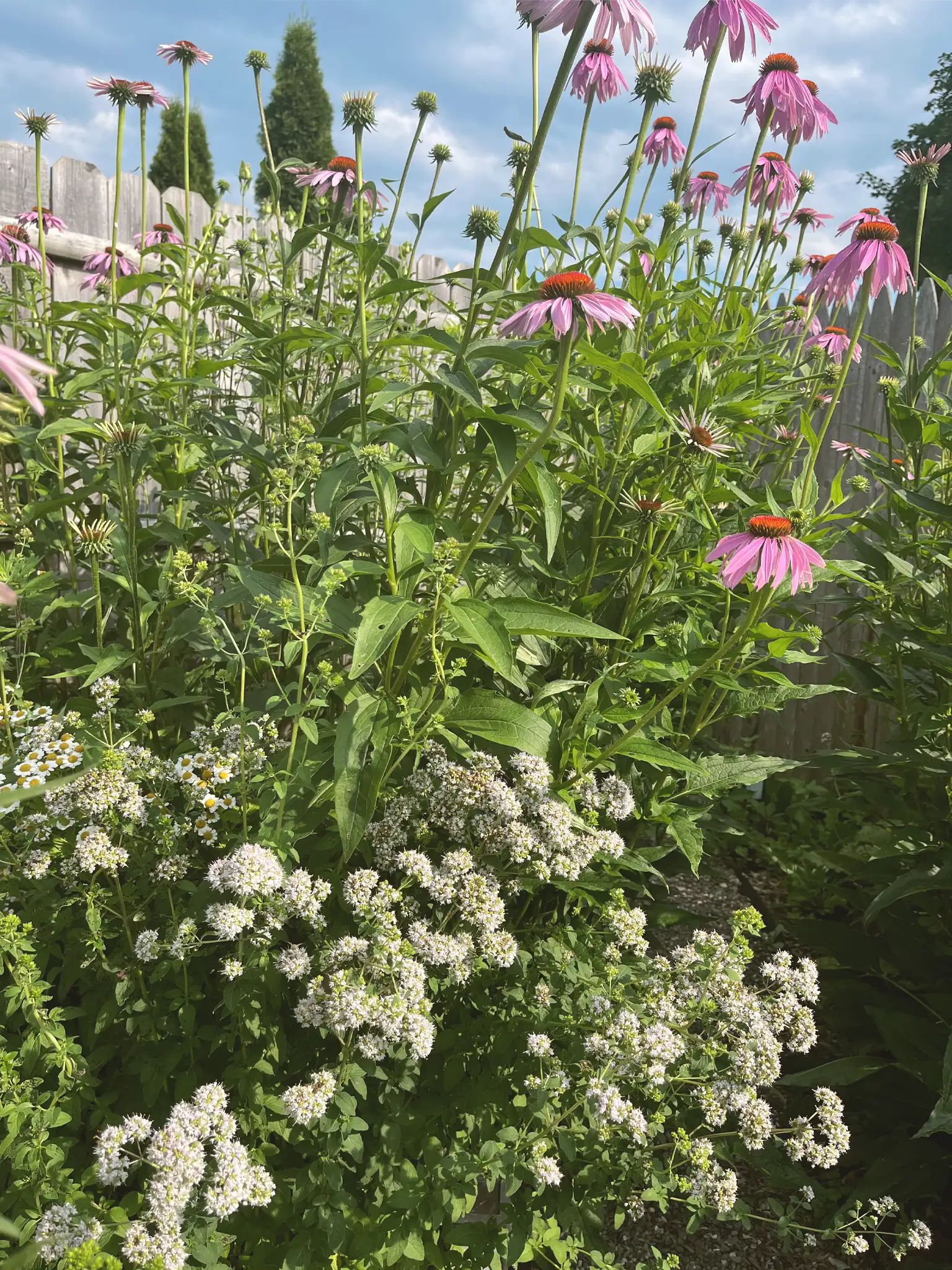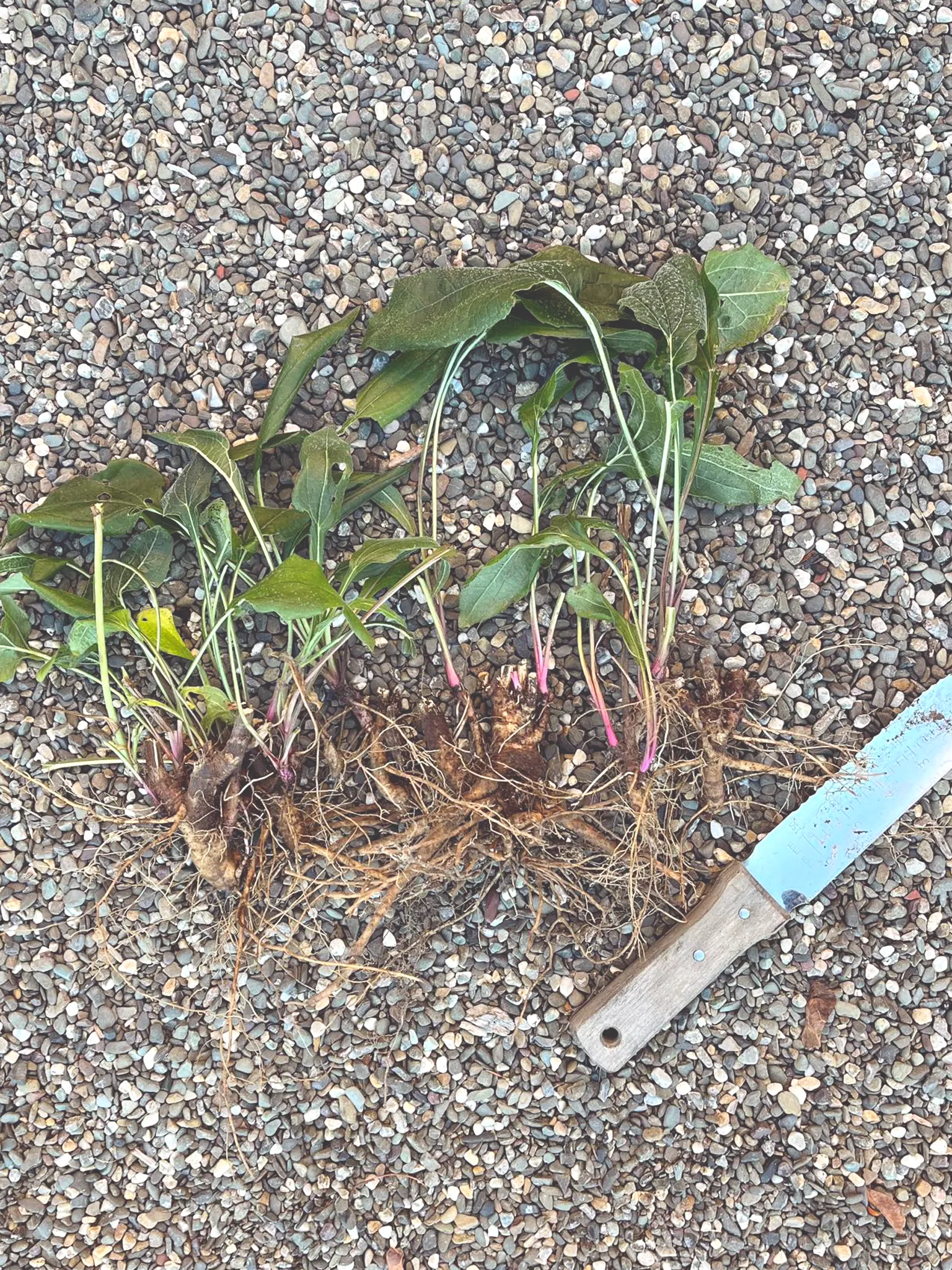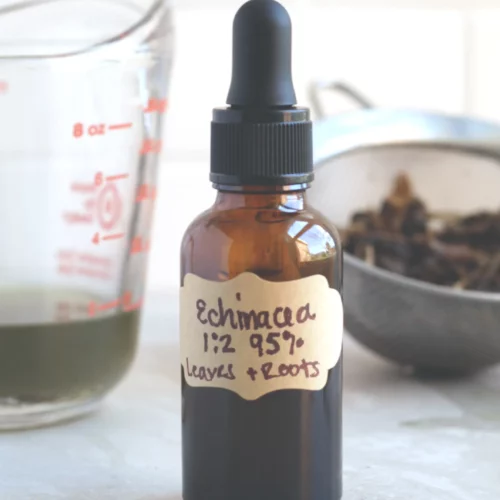Echinacea tincture is a must-have in my apothecary, and I always keep it well-stocked. I start taking it the second I feel a scratchy throat or the hint of a sniffle.
Echinacea, also known as purple coneflower, has immune-stimulating and anti-inflammatory properties that can help prevent or shorten the duration of colds and other respiratory infections. All parts of the plant contain medicinal properties.
I harvest the above ground parts (flowers, stems, and leaves) while the plant is in full bloom – usually around mid-July. In late October, I dig up the roots of plants that are at least 2 years old. The roots grow in clumps that can be divided and re-planted or used for tincturing.
I prefer using fresh roots over dried for tinctures, as they tend to produce a more potent medicine. To check the potency, I taste a small piece of the cleaned root to ensure the alkamides are active. When alkamides are strong, you’ll feel a numbing and tingling sensation on your tongue.

The most commonly used species of Echinacea are Echinacea angustifolia and Echinacea purpurea. E. purpurea is easily distinguished from E. angustifolia by the orange tipped cone of the flower heads.
I grow E. purpurea in my garden. It gets to about 3 or 4 feet in height, making them a stunning backdrop to shorter flowers, like California Poppy or Calendula.
Echinacea is a favorite of many butterflies, birds, and bees. My flower garden is often full of swallowtails, monarchs, goldfinches, and hummingbirds.
Overview
Tinctures are liquid extracts made from herbs that have been steeped in alcohol for an extended period of time. They’re a popular way to take herbal remedies because they’re easy to use and can be stored for several years.
I recommend taking Echinacea tincture with a little water, because the alkamides can be strong enough to irritate the throat.
The recipe involves combining fresh Echinacea roots into a high-proof alcohol for tincturing. The extraction takes about 4-6 weeks.
Equipment Needed
- Sterilized glass jar with a tight-fitting lid
- Cheesecloth or a fine-mesh strainer
- Funnel
- Amber glass dropper bottle
Ingredients
- 1 part fresh Echinacea roots
- 2 parts high-proof alcohol (such as vodka or grain alcohol)

Instructions Summary
- Harvest: Harvest fresh Echinacea roots in the late Fall. Choose plants that are at least 2 years old. Scrub the roots clean with cool water and chop into small pieces soon after harvesting.
- Prep: Sterilize your mason jar and make sure it’s completely dry before adding the ingredients. Add the roots and alcohol to the sterilized jar. Make sure the plant material is covered completely. Top off with a little more alcohol, as needed. The ratio of alcohol to Echinacea should be roughly 2:1 (for example, 2 cups alcohol to 1 cup roots).
- Store: Place the jar in a cool, dark place and let it sit for about 4-6 weeks. Shake the jar once a day to mix everything around. Don’t forget to label it!
- Strain: After four to six weeks, strain the tincture using a cheesecloth and a fine-mesh strainer. Squeeze the roots in the cheesecloth to extract all of the liquid. Use a funnel to transfer the tincture into amber glass dropper bottles. The amber glass will protect the tincture from light and help to preserve its potency.
- Long-term storage: Label the tincture with the date and the name of the herb. Store it in a cool, dark place. A tincture can last for several years if stored properly.

How to sterilize your mason jar or glass jar
- Wash the jar with hot soapy water and rinse thoroughly.
- Boil water in a large pot.
- Once the water is boiling, carefully lower the jar into the pot.
- Let the jar sit in the boiling water for about 10 minutes to sterilize it.
- Use tongs to remove the jar from the boiling water and place it on a clean towel or drying rack.
- Let the jar air dry completely or dry it with a clean towel.
How to Use Echinacea Tincture
It’s always best to consult with a qualified healthcare practitioner or herbalist who can help you determine the appropriate dosage based on your individual needs. However, here are some general guidelines for adults using an Echinacea tincture:
Immune Support: 1/2 teaspoon – 1 teaspoon three times a day at the onset of symptoms and for the duration of the illness.
Note 1: This information is general and for educational purposes only. Your personal health and dosing should be determined by you and your healthcare provider.
Note 2: Echinacea works best taken short-term during the illness. I do not recommend taking it long-term.
Contraindications of Echinacea
Echinacea is generally considered safe for most people when consumed in reasonable amounts, but there are a few things to keep in mind:
- Allergies: People allergic to plants in the daisy family (Asteraceae), such as ragweed, may experience allergic reactions to Echinacea.
- Autoimmune Conditions: People with autoimmune conditions should use caution with Echinacea, as it stimulates immune activity.
- Pregnancy and Nursing: Consult a healthcare provider before using Echinacea if pregnant or breastfeeding.

Echinacea Tincture
Equipment
- Sterilized glass jar with a tight-fitting lid
- Cheesecloth or a fine-mesh strainer
- Funnel
- Amber glass dropper bottle
Ingredients
- 1 part fresh Echinacea roots
- 2 parts high-proof alcohol such as vodka or grain alcohol
Instructions
- Harvest fresh Echinacea roots in the late Fall. Choose plants that are at least 2 years old. Scrub the roots clean with cool water and chop into small pieces soon after harvesting.
- Sterilize your mason jar and make sure it’s completely dry before adding the ingredients. Add the roots and alcohol to the sterilized jar. Make sure the plant material is covered completely. Top off with a little more alcohol, as needed. The ratio of alcohol to Echinacea should be roughly 2:1 (for example, 2 cups alcohol to 1 cup roots).
- Place the jar in a cool, dark place and let it sit for about 4-6 weeks. Shake the jar once a day to mix everything around. Don’t forget to label it!
- After four to six weeks, strain the tincture using a cheesecloth and a fine-mesh strainer. Squeeze the roots in the cheesecloth to extract all of the liquid. Use a funnel to transfer the tincture into amber glass dropper bottles. The amber glass will protect the tincture from light and help to preserve its potency.
- Label the tincture with the date and the name of the herb. Store it in a cool, dark place. A tincture can last for several years if stored properly.
Notes
- Allergies: People allergic to plants in the daisy family (Asteraceae), such as ragweed, may experience allergic reactions to Echinacea.
- Autoimmune Conditions: People with autoimmune conditions should use caution with Echinacea, as it stimulates immune activity.
- Pregnancy and Nursing: Consult a healthcare provider before using Echinacea if pregnant or breastfeeding.
Join Our Newsletter
Sign up for our monthly newsletter to get easy gardening tips, seasonal to-dos, and herbal recipes delivered right to your inbox.
Thank you!
Check your email to confirm your subscription.
References
Aucoin, M., Cardozo, V., McLaren, M. D., Garber, A., Remy, D., Baker, J., Gratton, A., Kala, M. A., Monteiro, S., Warder, C., Perciballi, A., & Cooley, K. (2021). A systematic review on the effects of Echinacea supplementation on cytokine levels: Is there a role in COVID-19? Metabolism Open, 11, 100115. https://doi.org/10.1016/j.metop.2021.100115
Manayi, A., Vazirian, M., & Saeidnia, S. (2015). Echinacea purpurea: Pharmacology, phytochemistry and analysis methods. Pharmacognosy reviews, 9(17), 63–72. https://doi.org/10.4103/0973-7847.156353
Weishaupt R, Bächler A, Feldhaus S, Lang G, Klein P, Schoop R. Safety and Dose-Dependent Effects of Echinacea for the Treatment of Acute Cold Episodes in Children: A Multicenter, Randomized, Open-Label Clinical Trial. Children. 2020; 7(12):292. https://doi.org/10.3390/children7120292














